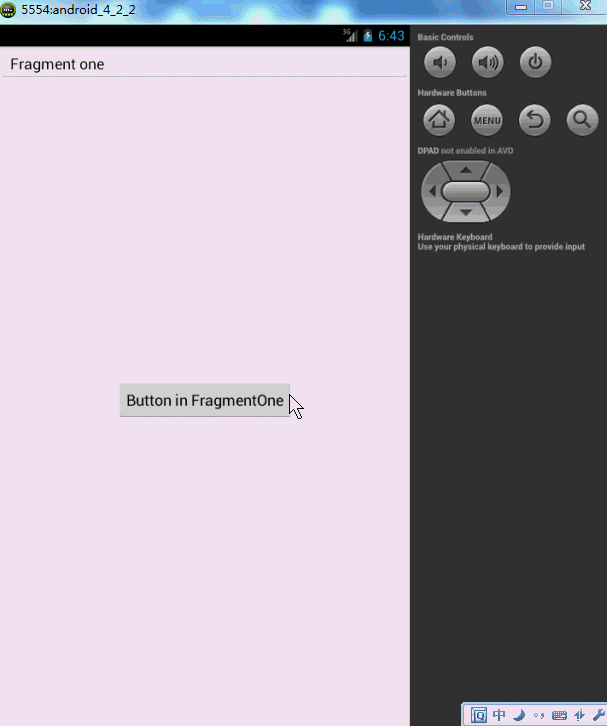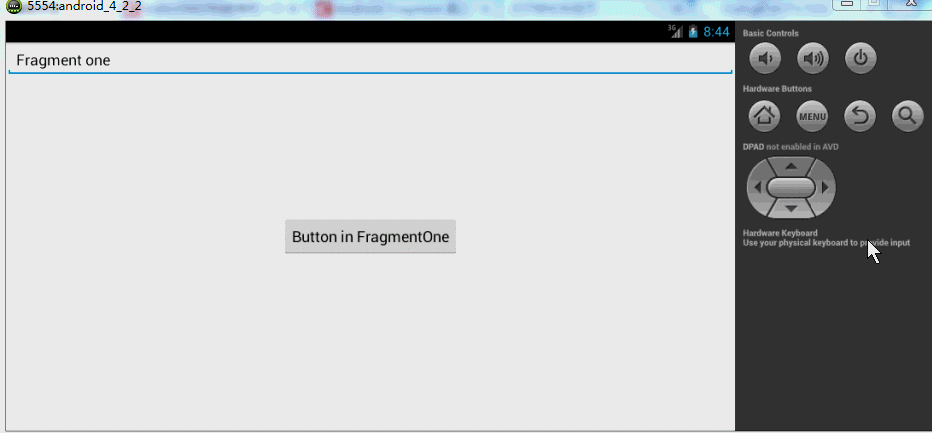fragment的学习主要是理解他到底起什么作用,然后是如何动态的切换fragment不出错,也就是管理fragment
作用就是:fragment可以当做view使用,更好的特点就是这个(fragment类型的view可以动态的增加,删除,替换)
基础的东西不再详细介绍,
下面是参考文章:http://www.cnblogs.com/Gaojiecai/p/4084252.html
http://blog.csdn.net/lmj623565791/article/details/37970961 博主是牛人
1、Fragment的产生与介绍
Android运行在各种各样的设备中,有小屏幕的手机,超大屏的平板甚至电视。针对屏幕尺寸的差距,很多情况下,都是先针对手机开发一套app,然后拷贝一份,修改布局以适应什么超级大屏的。难道无法做到一个app可以同时适应手机和平板吗?答案是,当然有,那就是Fragment.Fragment出现的初衷就是为了解决这样的问题。
你可以把Fragment当成Activity一个界面的一部分,甚至Activity的界面由完全不同的Fragment组成,更帅气的是Fragment有自己的声明周期和接收、处理用户的事件,这样就不必要在一个Activity里面写一堆事件、控件的代码了。更为重要的是,你可以动态的添加、替换、移除某个Fragment。
2、Fragment的生命周期
Fragment必须是依存于Activity而存在的,因此Activity的生命周期会直接影响到Fragment的生命周期。官网这张图很好的说明了俩者的关系:

可以看到Fragment比Activity多了几个额外的生命周期回调函数:
onAttach(Activity); //当Activity与Fragment发生关联时调用
onCreateView(LayoutInflater,ViewGroup,Bundle); //创建该Fragment的视图
onActivityCreate(bundle); //当Activity的onCreate();方法返回时调用
onDestoryView(); //与onCreateView相对应,当改Fragment被移除时调用
onDetach(); //与onAttach()相对应,当Fragment与Activity的关联被取消时调用
注意:除了onCreateView,其他的所有方法如果你重写了,必须调用父类对于该方法的实现。
3、静态的使用Fragment
接下来,就是实践的时候了,要注意了,开始写代码喽~~~~
这是使用Fragment最简单的一种方式,把Fragment当成普通的控件,直接写在Activity的布局文件中,用布局文件调用Fragment。
步骤:
1、继承Fragment,重写onCreateView决定Fragment布局。
2、在Activity中声明此Fragment,就当和普通的View一样。
下面展示一个例子(我使用俩个Fragment作为Activity的布局,一个Fragment用于标题布局,一个Fragment用于内容布局)。
TitleFragment的布局文件,在这里我们可以看出,我们可以每个Fragment当中进行单独的布局:
<?xml version="1.0" encoding="utf-8"?> <RelativeLayout xmlns:android="http://schemas.android.com/apk/res/android" android:layout_width="fill_parent" android:layout_height="45dp" android:background="@drawable/title_bar" > <ImageButton android:id="@+id/id_title_left_btn" android:layout_width="wrap_content" android:layout_height="fill_parent" android:layout_centerVertical="true" android:background="@drawable/showleft_selector" /> <TextView android:layout_width="fill_parent" android:layout_height="fill_parent" android:gravity="center" android:text="我不是微信" android:textColor="#fff" android:textSize="20sp" android:textStyle="bold" /> </RelativeLayout>
TitleFragment.java文件,在这里我们能够看到,可以在各个Fragment当中进行独立的初始化空间并且处理按钮之类的事件,减轻了Activity的负担,我们在Activity中就没有必要写一大推初始化控件和事件响应的代码了,这样就使我们的代码看上去更加的简洁了,可读性大大提高了。
public class TitleFragment extends Fragment { private ImageButton mButton; @SuppressLint("NewApi") @Override public View onCreateView(LayoutInflater inflater, ViewGroup container, Bundle savedInstanceState) { View view = inflater.inflate(R.layout.title_fragment, container, false); mButton = (ImageButton)view.findViewById(R.id.id_title_left_btn); mButton.setOnClickListener(new OnClickListener() { @Override public void onClick(View v) { Toast.makeText(getActivity(), "i am an ImageButton in TitleFragment ! ", Toast.LENGTH_SHORT).show(); } }); return view; } }
同理还有ContentFragment的布局文件content_fragment.xml
<?xml version="1.0" encoding="utf-8"?> <LinearLayout xmlns:android="http://schemas.android.com/apk/res/android" android:layout_width="match_parent" android:layout_height="match_parent" android:orientation="vertical" > <TextView android:layout_width="fill_parent" android:layout_height="fill_parent" android:gravity="center" android:text="使用Fragment做主面板" android:textSize="20sp" android:textStyle="bold" /> </LinearLayout>
同理还有ContentFragment.java文件
public class ContentFragment extends Fragment { @Override public View onCreateView(LayoutInflater inflater, ViewGroup container, Bundle savedInstanceState) { return inflater.inflate(R.layout.content_fragment, container,false); } }
下面就是主Activity以及他的布局文件
MainActivity.java文件
public class MainActivity extends Activity { @Override protected void onCreate(Bundle savedInstanceState) { super.onCreate(savedInstanceState); requestWindowFeature(Window.FEATURE_NO_TITLE); setContentView(R.layout.activity_main); } }
activity_main.xml文件,在这里我们可以看到,我们把Fragment就当做普通的控件一样,在xml文件中使用。
<RelativeLayout xmlns:android="http://schemas.android.com/apk/res/android" xmlns:tools="http://schemas.android.com/tools" android:layout_width="match_parent" android:layout_height="match_parent" tools:context="com.example.staticfragment.MainActivity" > <fragment android:name="com.example.staticfragment.TitleFragment" android:id="@+id/title" android:layout_height="45dp" android:layout_width="match_parent"/> <fragment android:layout_below="@id/title" android:name="com.example.staticfragment.ContentFragment" android:id="@+id/content" android:layout_height="fill_parent" android:layout_width="fill_parent"/> </RelativeLayout>
运行效果截图如下:

注:由于时间原因,就没有上传源码,如果需要demo源码的话,可以留言,我单独发你一下...
4、动态的使用Fragment
上面已经演示了最简单的使用Fragment的方式,下面分享一下如何动态的添加、更新、以及删除Fragment。
首先是,MainActivity的布局文件activity_main.xml,该文件布局文件上面的顶部是一个TitleFragment,是一个静态声明的Fragment。
中间也是一个Fragment,但是这个Fragment是动态使用的。
最下面是四个按钮。用include标签包含外部的布局文件进来的。
<RelativeLayout xmlns:android="http://schemas.android.com/apk/res/android" xmlns:tools="http://schemas.android.com/tools" android:layout_width="match_parent" android:layout_height="match_parent" > <fragment android:id="@+id/id_fragment_title" android:name="com.example.dynamicfragment.TitleFragment" android:layout_width="fill_parent" android:layout_height="45dp" /> <include android:id="@+id/id_ly_bottombar" android:layout_width="fill_parent" android:layout_height="55dp" android:layout_alignParentBottom="true" layout="@layout/bottombar" /> <FrameLayout android:id="@+id/id_content" android:layout_width="fill_parent" android:layout_height="fill_parent" android:layout_above="@id/id_ly_bottombar" android:layout_below="@id/id_fragment_title" /> </RelativeLayout>
然后是,MainActivity.java文件。也是我们这个demo当中最重要的代码文件,首先是将上面的布局文件通过setContentView()加载进来.然后是通过setDefaultFragment();将默认的ContentFragment动态的加载进来。接下来就是通过我们在最下面防止的四个按钮可以随意的动态切换Fragment。这也是为什么Fragment会有如此火的原因吧~~~^^
public class MainActivity extends ActionBarActivity implements OnClickListener { private ImageButton mTabWeixin; private ImageButton mTabFriend; private ImageButton mTabDiscover; private ImageButton mTabMe; private ContentFragment mWeiXinFragment; private FriendFragment mFriendFragment; @Override protected void onCreate(Bundle savedInstanceState) { super.onCreate(savedInstanceState); requestWindowFeature(Window.FEATURE_NO_TITLE); setContentView(R.layout.activity_main); initView(); } public void initView() { // 初始化控件和声明事件 mTabWeixin = (ImageButton) findViewById(R.id.weixin); mTabFriend = (ImageButton) findViewById(R.id.friend); mTabWeixin.setOnClickListener(this); mTabFriend.setOnClickListener(this); // 设置默认的Fragment setDefaultFragment(); } @SuppressLint("NewApi") private void setDefaultFragment() { FragmentManager manager = getFragmentManager(); FragmentTransaction transaction = manager.beginTransaction(); mWeiXinFragment = new ContentFragment(); transaction.replace(R.id.id_content, mWeiXinFragment); transaction.commit(); } @SuppressLint("NewApi") @Override public void onClick(View v) { FragmentManager fm = getFragmentManager(); // 开启Fragment事务 FragmentTransaction transaction = fm.beginTransaction(); switch (v.getId()) { case R.id.weixin: if (mWeiXinFragment == null) { mWeiXinFragment = new ContentFragment(); } // 使用当前Fragment的布局替代id_content的控件 transaction.replace(R.id.id_content, mWeiXinFragment); break; case R.id.friend: if (mFriendFragment == null) { mFriendFragment = new FriendFragment(); } transaction.replace(R.id.id_content, mFriendFragment); break; } // transaction.addToBackStack(); // 事务提交 transaction.commit(); } }
从上面的代码,我们可以看出,我们可以使用FragmentManager对Fragment进行动态的加载,这里使用的replace方法~~~下一节我们会详细的介绍FragmentManager的常用API。。。。^^
注:如果使用android3.0一下的版本,需要引入v4的包,然后Activity继承FragmentActivity,然后通过getSupportFragmentManager()获得FragmentManager对象,不过还是建议把Menifest文件的uses-sdk的minSdkVersion和targetSdkVersion都改为11以上,这样就不必引入v4的包了。
代码的中间有俩个动态加载进来的Fragment,这个和静态使用ragment的声明方式是一样的,写一个继承Fragment的类,然后设置相应的布局,由于时间的关系,我这里只写了俩个Fragment,现在把这俩个的代码页贴出来:
第一个Fragment和他相应的布局文件:
public class ContentFragment extends Fragment { @Override public View onCreateView(LayoutInflater inflater, ViewGroup container, Bundle savedInstanceState) { return inflater.inflate(R.layout.fragment_content, container, false); } }
<?xml version="1.0" encoding="utf-8"?> <LinearLayout xmlns:android="http://schemas.android.com/apk/res/android" android:layout_width="match_parent" android:layout_height="match_parent" android:orientation="vertical" > <TextView android:layout_width="fill_parent" android:layout_height="fill_parent" android:gravity="center" android:text="weixin" android:textSize="20sp" android:textStyle="bold" /> </LinearLayout>
第二个Fragment和他相应的布局文件:
public class FriendFragment extends Fragment { @Override public View onCreateView(LayoutInflater inflater, ViewGroup container, Bundle savedInstanceState) { return inflater.inflate(R.layout.fragment_friend, container, false); } }
<?xml version="1.0" encoding="utf-8"?> <LinearLayout xmlns:android="http://schemas.android.com/apk/res/android" android:layout_width="match_parent" android:layout_height="match_parent" android:orientation="vertical" > <TextView android:layout_width="fill_parent" android:layout_height="fill_parent" android:gravity="center" android:text="friend" android:textSize="20sp" android:textStyle="bold" /> </LinearLayout>
好了,现在基本的代码都有了,我们把demo的运行图贴出来给大家分享一下(注:时间原因,没注意布局以及图片的美化,只是功能的实现),这是分别点击下面第一个和第二个按钮的效果图,从而实现了中间用一个Fragment动态的加载这俩个Fragment的显示。


ps:为了代码的简洁,就不添加按钮的点击变化什么的了,主要讲解功能了~~~
5、Fragment常用的API:
Fragment常用的三个类:
android.app.Fragment 主要用于定义Fragment
android.app.FragmentManager 主要用于在Activity中操作Fragment
android.app.FragmentTransaction 保证一些列Fragment操作的原子性,熟悉事务这个词,一定能明白~
a、获取FragmentManage的方式:
getFragmentManager() // v4中,getSupportFragmentManager
b、主要的操作都是FragmentTransaction的方法
FragmentTransaction transaction = fm.benginTransatcion();//开启一个事务
transaction.add()
往Activity中添加一个Fragment
transaction.remove()
从Activity中移除一个Fragment,如果被移除的Fragment没有添加到回退栈(回退栈后面会详细说),这个Fragment实例将会被销毁。
transaction.replace()
使用另一个Fragment替换当前的,实际上就是remove()然后add()的合体~
transaction.hide()
隐藏当前的Fragment,仅仅是设为不可见,并不会销毁
transaction.show()
显示之前隐藏的Fragment
detach()
将此Fragment从Activity中分离,会销毁其布局,但不会销毁该实例
attach()
将从Activity中分离的Fragment,重新关联到该Activity,重新创建其视图层次
transatcion.commit()//提交一个事务
注意:常用Fragment的哥们,可能会经常遇到这样Activity状态不一致:State loss这样的错误。主要是因为:commit方法一定要在Activity.onSaveInstance()之前调用。
上述,基本是操作Fragment的所有的方式了,在一个事务开启到提交可以进行多个的添加、移除、替换等操作。
值得注意的是:如果你喜欢使用Fragment,一定要清楚这些方法,哪个会销毁视图,哪个会销毁实例,哪个仅仅只是隐藏,这样才能更好的使用它们。
a、比如:我在FragmentA中的EditText填了一些数据,当切换到FragmentB时,如果希望会到A还能看到数据,则适合你的就是hide和show;也就是说,希望保留用户操作的面板,你可以使用hide和show,当然了不要使劲在那new实例,进行下非null判断。
b、再比如:我不希望保留用户操作,你可以使用remove(),然后add();或者使用replace()这个和remove,add是相同的效果。
c、remove和detach有一点细微的区别,在不考虑回退栈的情况下,remove会销毁整个Fragment实例,而detach则只是销毁其视图结构,实例并不会被销毁。那么二者怎么取舍使用呢?如果你的当前Activity一直存在,那么在不希望保留用户操作的时候,你可以优先使用detach。
上述已经介绍完成了Fragment常用的一些方法,相信看完,大家一定清楚了Fragment的产生理由,以及如何使用Fragment,再根据API的讲解,也能明白,曾经为何觉得Fragment会出现一些列乱七八槽的问题,终究是因为没有弄清楚其生命周期。
转载请标明出处:http://blog.csdn.net/lmj623565791/article/details/37992017
上篇博客中已经介绍了Fragment产生原因,以及一些基本的用法和各种API,如果你还不了解,请看:Android Fragment 真正的完全解析(上)。
本篇将介绍上篇博客提到的:如何管理Fragment回退栈,Fragment如何与Activity交互,Fragment与Activity交互的最佳实践,没有视图的Fragment的用处,使用Fragment创建对话框,如何与ActionBar,MenuItem集成等~~
1、管理Fragment回退栈
类似与Android系统为Activity维护一个任务栈,我们也可以通过Activity维护一个回退栈来保存每次Fragment事务发生的变化。如果你将Fragment任务添加到回退栈,当用户点击后退按钮时,将看到上一次的保存的Fragment。一旦Fragment完全从后退栈中弹出,用户再次点击后退键,则退出当前Activity。
看这样一个效果图:
点击第一个按钮,切换到第二个界面,点击第二个按钮,切换到第三个界面,然后点击Back键依次回退。这像不像初学Android时的Activity跳转,当然了,这里肯定不是,不然我就跪了。这里是Fragment实现的,用户点击Back,实际是Fragment回退栈不断的弹栈。
如何添加一个Fragment事务到回退栈:
FragmentTransaction.addToBackStack(String)
下面讲解代码:很明显一共是3个Fragment和一个Activity.
先看Activity的布局文件:
不同的Fragment就在这个FrameLayout中显示。
MainActivity.java
很简单,直接将FragmentOne添加到布局文件中的FrameLayout中,注意这里并没有调用FragmentTransaction.addToBackStack(String),因为我不喜欢在当前显示时,点击Back键出现白板。而是正确的相应Back键,即退出我们的Activity.
下面是FragmentOne
我们在点击FragmentOne中的按钮时,使用了replace方法,如果你看了前一篇博客,一定记得replace是remove和add的合体,并且如果不添加事务到回退栈,前一个Fragment实例会被销毁。这里很明显,我们调用tx.addToBackStack(null);将当前的事务添加到了回退栈,所以FragmentOne实例不会被销毁,但是视图层次依然会被销毁,即会调用onDestoryView和onCreateView,证据就是:仔细看上面的效果图,我们在跳转前在文本框输入的内容,在用户Back得到第一个界面的时候不见了。
接下来FragmentTwo
这里点击时,我们没有使用replace,而是先隐藏了当前的Fragment,然后添加了FragmentThree的实例,最后将事务添加到回退栈。这样做的目的是为了给大家提供一种方案:如果不希望视图重绘该怎么做,请再次仔细看效果图,我们在FragmentTwo的EditText填写的内容,用户Back回来时,数据还在~~~
最后FragmentThree就是简单的Toast了:
好了,经过上面的介绍,应该已经知道Fragment回退栈是怎么一回事了,以及hide,replace等各自的应用的场景。
这里极其注意一点:上面的整体代码不具有任何参考价值,纯粹为了显示回退栈,在后面讲解了Fragment与Activity通信以后,会重构上面的代码!
2、Fragment与Activity通信
因为所有的Fragment都是依附于Activity的,所以通信起来并不复杂,大概归纳为:
a、如果你Activity中包含自己管理的Fragment的引用,可以通过引用直接访问所有的Fragment的public方法
b、如果Activity中未保存任何Fragment的引用,那么没关系,每个Fragment都有一个唯一的TAG或者ID,可以通过getFragmentManager.findFragmentByTag()或者findFragmentById()获得任何Fragment实例,然后进行操作。
c、在Fragment中可以通过getActivity得到当前绑定的Activity的实例,然后进行操作。
注:如果在Fragment中需要Context,可以通过调用getActivity(),如果该Context需要在Activity被销毁后还存在,则使用getActivity().getApplicationContext()。
3、Fragment与Activity通信的最佳实践
因为要考虑Fragment的重复使用,所以必须降低Fragment与Activity的耦合,而且Fragment更不应该直接操作别的Fragment,毕竟Fragment操作应该由它的管理者Activity来决定。
下面我通过两种方式的代码,分别重构,FragmentOne和FragmentTwo的点击事件,以及Activity对点击事件的响应:
首先看FragmentOne
可以看到现在的FragmentOne不和任何Activity耦合,任何Activity都可以使用;并且我们声明了一个接口,来回调其点击事件,想要管理其点击事件的Activity实现此接口就即可。可以看到我们在onClick中首先判断了当前绑定的Activity是否实现了该接口,如果实现了则调用。
再看FragmentTwo
与FragmentOne极其类似,但是我们提供了setListener这样的方法,意味着Activity不仅需要实现该接口,还必须显示调用mFTwo.setfTwoBtnClickListener(this)。
最后看Activity :
代码重构结束,与开始的效果一模一样。上面两种通信方式都是值得推荐的,随便选择一种自己喜欢的。这里再提一下:虽然Fragment和Activity可以通过getActivity与findFragmentByTag或者findFragmentById,进行任何操作,甚至在Fragment里面操作另外的Fragment,但是没有特殊理由是绝对不提倡的。Activity担任的是Fragment间类似总线一样的角色,应当由它决定Fragment如何操作。另外虽然Fragment不能响应Intent打开,但是Activity可以,Activity可以接收Intent,然后根据参数判断显示哪个Fragment。
4、如何处理运行时配置发生变化
运行时配置发生变化,最常见的就是屏幕发生旋转,如果你不知道如何处理屏幕变化可以参考:Android 屏幕旋转 处理 AsyncTask 和 ProgressDialog 的最佳方案
这里提一下:很多人觉得强制设置屏幕的方向就可以了,但是有一点,当你的应用被至于后台(例如用户点击了home),长时间没有返回的时候,你的应用也会被重新启动。比如上例:如果你把上面的例子你至于FragmentThree界面,然后处于后台状态,长时间后你会发现当你再次通过home打开时,上面FragmentThree与FragmentOne叠加在一起,这就是因为你的Activity重新启动,在原来的FragmentThree上又绘制了一个FragmentOne。
好了,下面看一段代码:
Activity:
Fragment
很简单的代码,当你运行之后,不断的旋转屏幕,你会发现每旋转一次屏幕,屏幕上就多了一个FragmentOne的实例,并且后台log会打印出许多套生命周期的回调。
类似:
这是为什么呢,因为当屏幕发生旋转,Activity发生重新启动,默认的Activity中的Fragment也会跟着Activity重新创建;这样造成当旋转的时候,本身存在的Fragment会重新启动,然后当执行Activity的onCreate时,又会再次实例化一个新的Fragment,这就是出现的原因。
那么如何解决呢:
其实通过检查onCreate的参数Bundle savedInstanceState就可以判断,当前是否发生Activity的重新创建:
默认的savedInstanceState会存储一些数据,包括Fragment的实例:通过打印可以看出:
所以,我们简单改一下代码,只有在savedInstanceState==null时,才进行创建Fragment实例:
现在无论进行多次旋转都只会有一个Fragment实例在Activity中。
现在还存在一个问题,就是重新绘制时,Fragment发生重建,原本的数据如何保持?
其实和Activity类似,Fragment也有onSaveInstanceState的方法,在此方法中进行保存数据,然后在onCreate或者onCreateView或者onActivityCreated进行恢复都可以。
由于篇幅原因,就不贴测试代码了。
5、Fragmeny与ActionBar和MenuItem集成
Fragment可以添加自己的MenuItem到Activity的ActionBar或者可选菜单中。
a、在Fragment的onCreate中调用 setHasOptionsMenu(true);
b、然后在Fragment子类中实现onCreateOptionsMenu
c、如果希望在Fragment中处理MenuItem的点击,也可以实现onOptionsItemSelected;当然了Activity也可以直接处理该MenuItem的点击事件。
代码:
Fragment
Activity
效果图:
好了,可以很好的看到,Fragment可以添加MenuItem,也可以自己处理点击~~~
6、没有布局的Fragment的作用
没有布局文件Fragment实际上是为了保存,当Activity重启时,保存大量数据准备的
请参考博客:Android 屏幕旋转 处理 AsyncTask 和 ProgressDialog 的最佳方案
7、使用Fragment创建对话框
这是Google推荐的方式,我也单独写过博客介绍,请参考:Android 官方推荐 : DialogFragment 创建对话框
博主写的真的很好,遇到的问题这里面基本都说的非常的清楚了,有一个地方就是宿主activity里面onCreate判断bundle不为空的时候,如果我需要知道详细的是那个fragment还在状态保存里面,可以调用getFragmentByTag把所有的fragment都找到,判断谁不为空,就是谁,这样就可以清晰的知道是上次离开的是哪个fragment,如果有特殊事件,还可以特别处理。
关于fragment里面设置回调和设置自己的菜单事件,真的写的非常的清晰明了,厉害

























 675
675

 被折叠的 条评论
为什么被折叠?
被折叠的 条评论
为什么被折叠?








